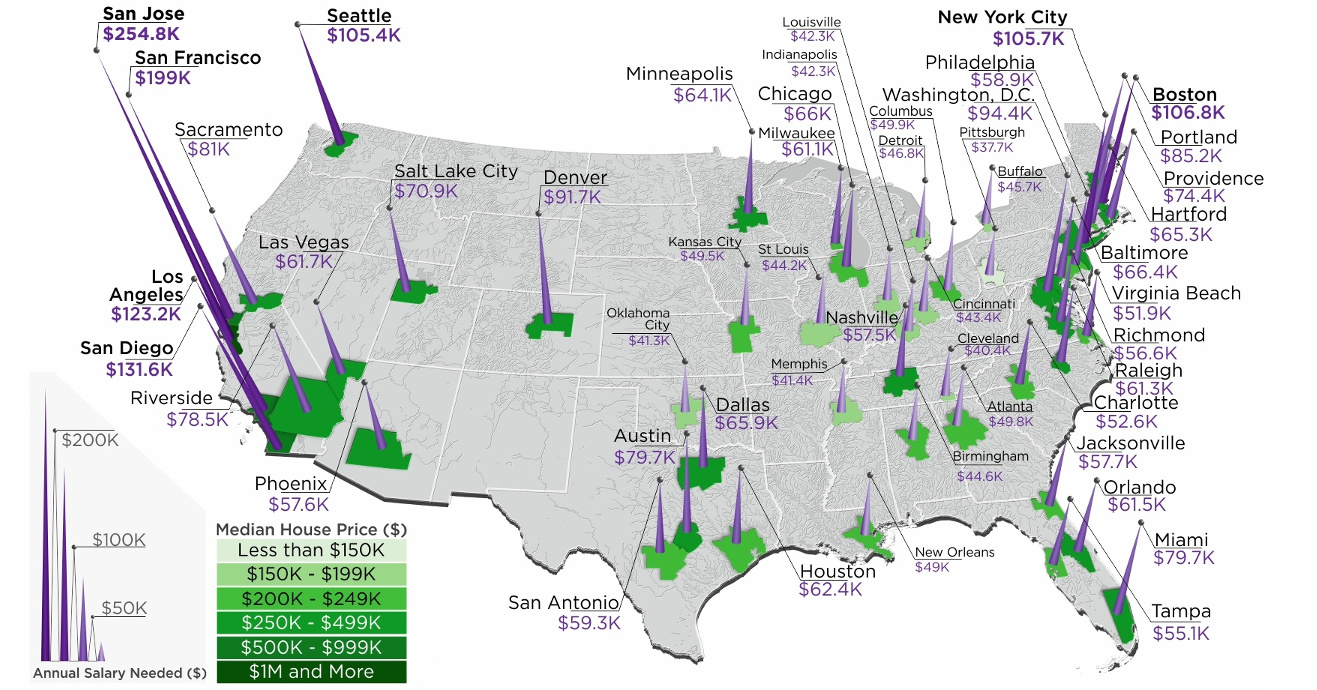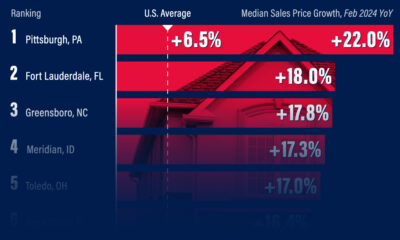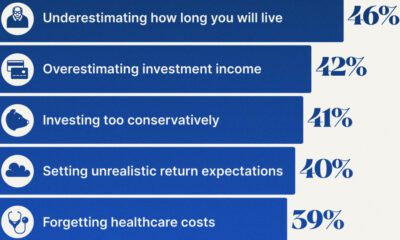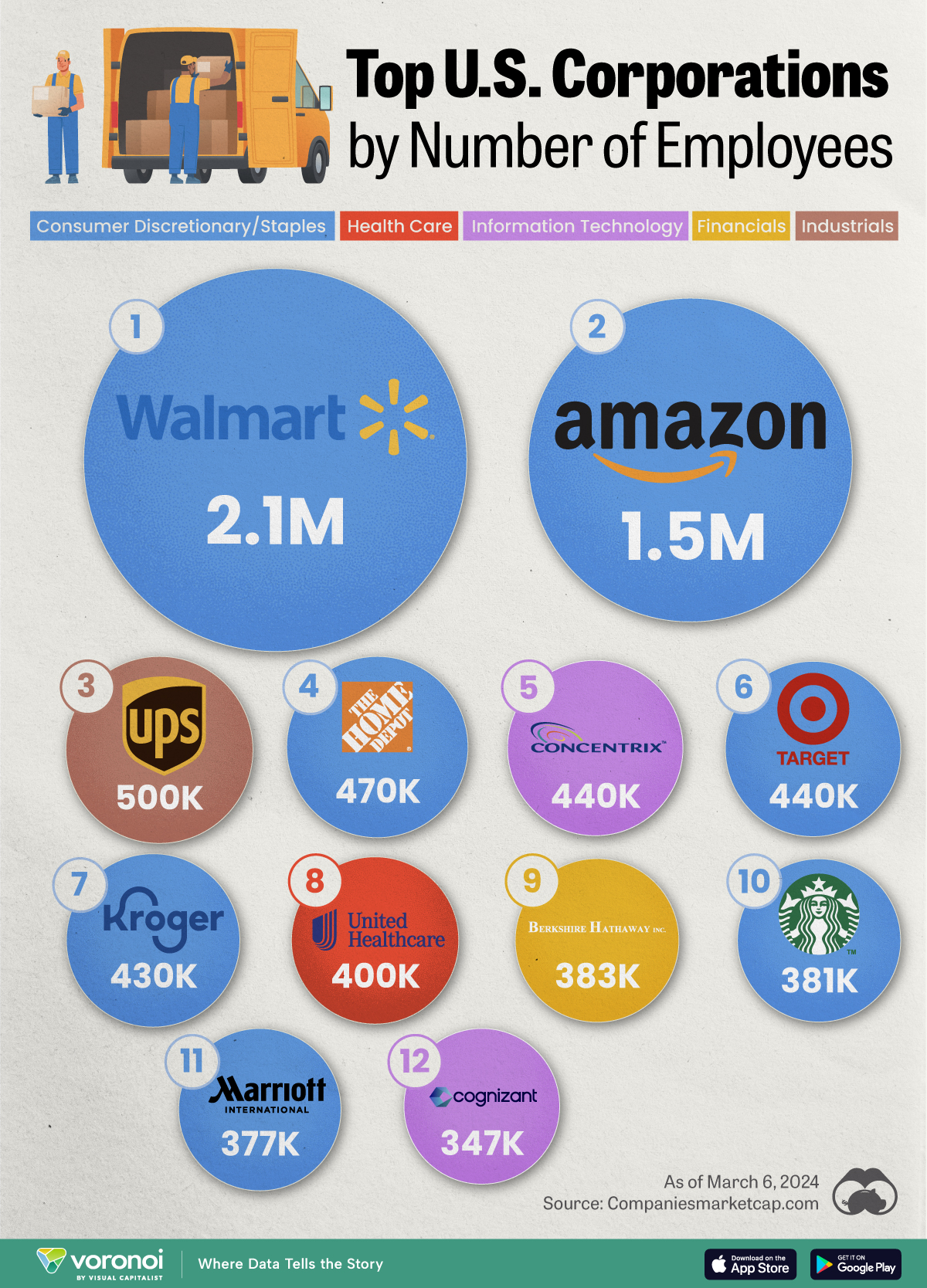Markets
Mapped: The Salary Needed to Buy a Home in 50 U.S. Metro Areas
Check out the latest 2023 update of the salary needed to buy a home in the U.S.
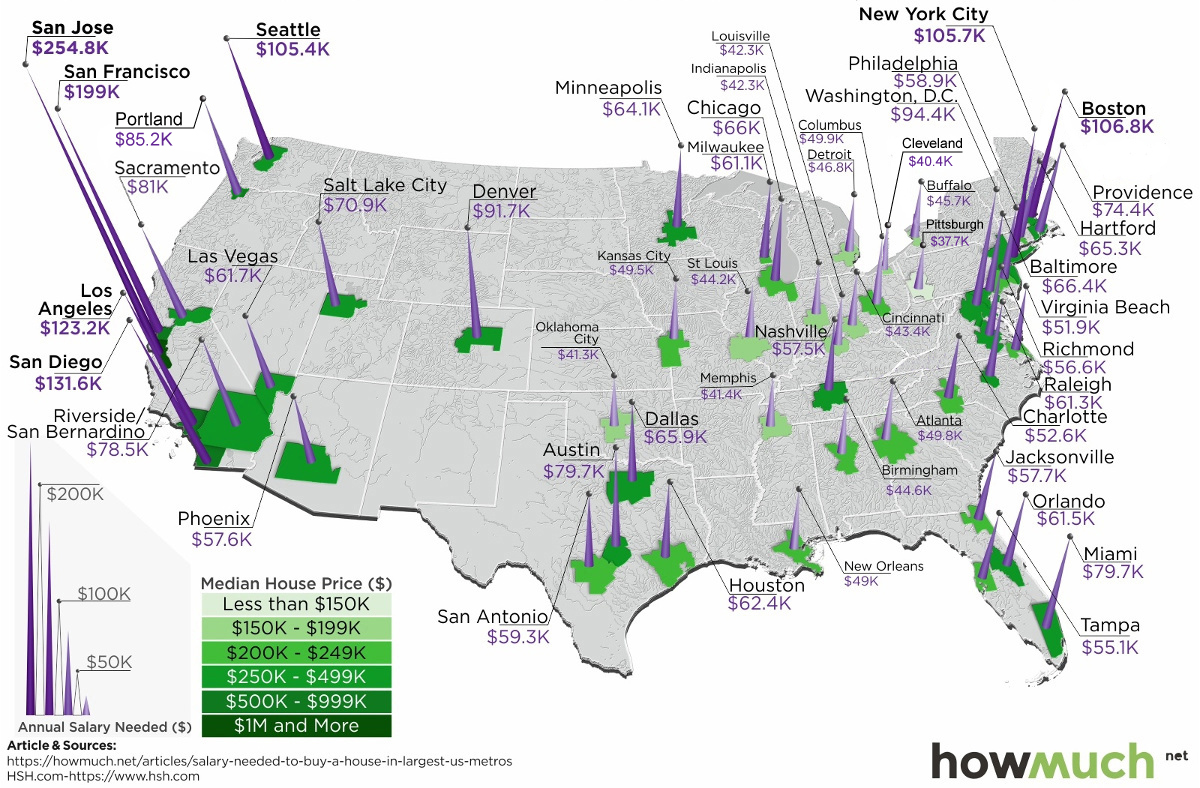
The Salary Needed to Buy a Home in 50 U.S. Metro Areas
Check out the latest 2023 update of the salary needed to buy a home in the U.S.
Over the last year, home prices have risen in 49 of the biggest 50 metro areas in the United States.
At the same time, mortgage rates have hit seven-year highs, making things more expensive for any prospective home buyer.
With this context in mind, today’s map comes from HowMuch.net, and it shows the salary needed to buy a home in the 50 largest U.S. metro areas.
The Least and Most Expensive Metro Areas
As a reference point, the median home in the United States costs about $257,600, according to the National Association of Realtors.
| Median Home Price | Montly Payment (PITI) | Salary Needed | |
|---|---|---|---|
| National | $257,600 | $1,433.91 | $61,453.51 |
With a 20% down payment and a 4.90% mortgage rate, and taking into account what’s needed to pay principal, interest, taxes, and insurance (PITI) on the home, it would mean a prospective buyer would need to have $61,453.51 in salary to afford such a purchase.
However, based on your frame of reference, this national estimate may seem extremely low or quite high. That’s because the salary required to buy in different major cities in the U.S. can fall anywhere between $37,659 to $254,835.
The 10 Cheapest Metro Areas
Here are the cheapest metro areas in the U.S., based on data and calculations from HSH.com:
| Rank | Metro Area | Median Home Price | Monthly Payment (PITI) | Salary Needed |
|---|---|---|---|---|
| #1 | Pittsburgh | $141,625 | $878.73 | $37,659.86 |
| #2 | Cleveland | $150,100 | $943.55 | $40,437.72 |
| #3 | Oklahoma City | $161,000 | $964.49 | $41,335.41 |
| #4 | Memphis | $174,000 | $966.02 | $41,400.93 |
| #5 | Indianapolis | $185,200 | $986.74 | $42,288.92 |
| #6 | Louisville | $180,100 | $987.54 | $42,323.15 |
| #7 | Cincinnati | $169,400 | $1,013.37 | $43,429.97 |
| #8 | St. Louis | $174,100 | $1,031.70 | $44,215.56 |
| #9 | Birmingham | $202,300 | $1,040.51 | $44,593.35 |
| #10 | Buffalo | $154,200 | $1,066.29 | $45,698.05 |
After the dust settles, Pittsburgh ranks as the cheapest metro area in the U.S. to buy a home. According to these calculations, buying a median home in Pittsburgh – which includes the surrounding metro area – requires an annual income of less than $40,000 to buy.
Just missing the list was Detroit, where a salary of $48,002.89 is needed.
The 10 Most Expensive Metro Areas
Now, here are the priciest markets in the country, also based on data from HSH.com:
| Rank | Metro Area | Median Home Price | Monthly Payment (PITI) | Salary Needed |
|---|---|---|---|---|
| #1 | San Jose | $1,250,000 | $5,946.17 | $254,835.73 |
| #2 | San Francisco | $952,200 | $4,642.82 | $198,978.01 |
| #3 | San Diego | $626,000 | $3,071.62 | $131,640.79 |
| #4 | Los Angeles | $576,100 | $2,873.64 | $123,156.01 |
| #5 | Boston | $460,300 | $2,491.76 | $106,789.93 |
| #6 | New York City | $403,900 | $2,465.97 | $105,684.33 |
| #7 | Seattle | $489,600 | $2,458.58 | $105,367.89 |
| #8 | Washington, D.C. | $417,400 | $2,202.87 | $94,408.70 |
| #9 | Denver | $438,300 | $2,139.02 | $91,672.45 |
| #10 | Portland | $389,000 | $1,987.37 | $85,173.08 |
Topping the list of the most expensive metro areas are San Jose and San Francisco, which are both cities fueled by the economic boom in Silicon Valley. Meanwhile, two other major metro areas in California, Los Angeles and San Diego, are not far behind.
New York City only ranks in sixth here, though it is worth noting that the NYC metro area extends well beyond the five boroughs. It includes Newark, Jersey City, and many nearby counties as well.
As a final point, it’s worth mentioning that all cities here (with the exception of Denver) are in coastal states.
Notes on Calculations
Data on median home prices comes from the National Association of Realtors and is based on 2018 Q4 information, while national mortgage rate data is derived from weekly surveys by Freddie Mac and the Mortgage Bankers Association of America for 30-year fixed rate mortgages.
Calculations include tax and homeowners insurance costs to determine the annual salary it takes to afford the base cost of owning a home (principal, interest, property tax and homeowner’s insurance, or PITI) in the nation’s 50 largest metropolitan areas.
Standard 28% “front-end” debt ratios and a 20% down payments subtracted from the median-home-price data are used to arrive at these figures.
Markets
Ranked: The Largest U.S. Corporations by Number of Employees
We visualized the top U.S. companies by employees, revealing the massive scale of retailers like Walmart, Target, and Home Depot.
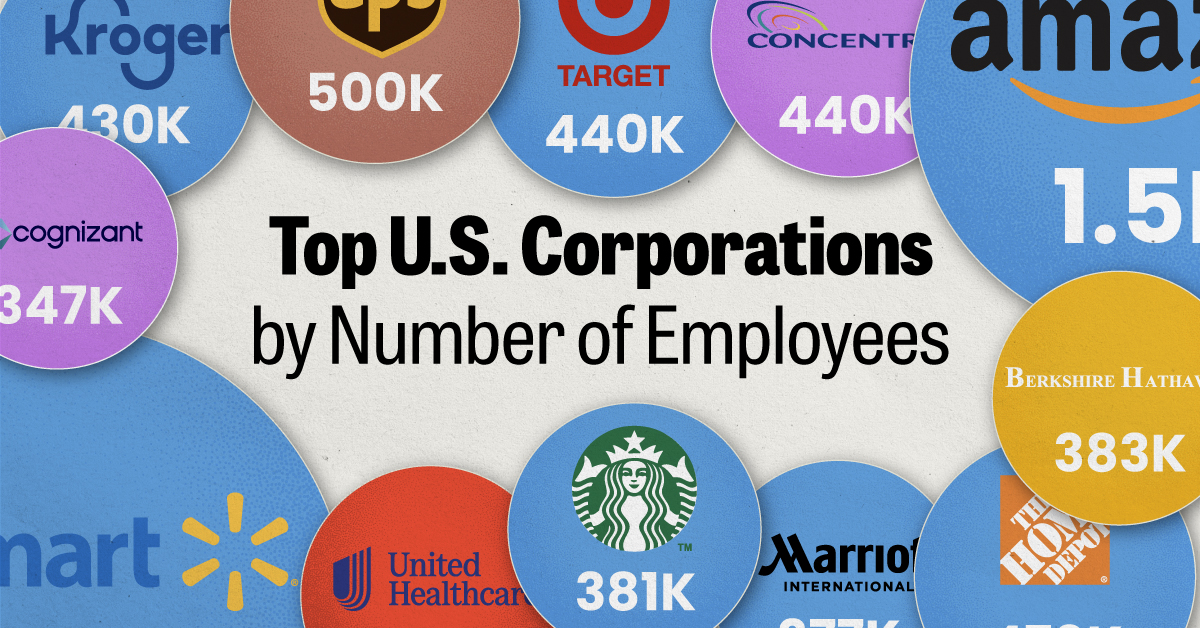
The Largest U.S. Corporations by Number of Employees
This was originally posted on our Voronoi app. Download the app for free on Apple or Android and discover incredible data-driven charts from a variety of trusted sources.
Revenue and profit are common measures for measuring the size of a business, but what about employee headcount?
To see how big companies have become from a human perspective, we’ve visualized the top U.S. companies by employees. These figures come from companiesmarketcap.com, and were accessed in March 2024. Note that this ranking includes publicly-traded companies only.
Data and Highlights
The data we used to create this list of largest U.S. corporations by number of employees can be found in the table below.
| Company | Sector | Number of Employees |
|---|---|---|
| Walmart | Consumer Staples | 2,100,000 |
| Amazon | Consumer Discretionary | 1,500,000 |
| UPS | Industrials | 500,000 |
| Home Depot | Consumer Discretionary | 470,000 |
| Concentrix | Information Technology | 440,000 |
| Target | Consumer Staples | 440,000 |
| Kroger | Consumer Staples | 430,000 |
| UnitedHealth | Health Care | 400,000 |
| Berkshire Hathaway | Financials | 383,000 |
| Starbucks | Consumer Discretionary | 381,000 |
| Marriott International | Consumer Discretionary | 377,000 |
| Cognizant | Information Technology | 346,600 |
Retail and Logistics Top the List
Companies like Walmart, Target, and Kroger have a massive headcount due to having many locations spread across the country, which require everything from cashiers to IT professionals.
Moving goods around the world is also highly labor intensive, explaining why UPS has half a million employees globally.
Below the Radar?
Two companies that rank among the largest U.S. corporations by employees which may be less familiar to the public include Concentrix and Cognizant. Both of these companies are B2B brands, meaning they primarily work with other companies rather than consumers. This contrasts with brands like Amazon or Home Depot, which are much more visible among average consumers.
A Note on Berkshire Hathaway
Warren Buffett’s company doesn’t directly employ 383,000 people. This headcount actually includes the employees of the firm’s many subsidiaries, such as GEICO (insurance), Dairy Queen (retail), and Duracell (batteries).
If you’re curious to see how Buffett’s empire has grown over the years, check out this animated graphic that visualizes the growth of Berkshire Hathaway’s portfolio from 1994 to 2022.
-

 Markets2 weeks ago
Markets2 weeks agoAmerica’s Top Companies by Revenue (1994 vs. 2023)
-

 Environment1 week ago
Environment1 week agoRanked: Top Countries by Total Forest Loss Since 2001
-

 Real Estate2 weeks ago
Real Estate2 weeks agoVisualizing America’s Shortage of Affordable Homes
-

 Maps2 weeks ago
Maps2 weeks agoMapped: Average Wages Across Europe
-

 Mining2 weeks ago
Mining2 weeks agoCharted: The Value Gap Between the Gold Price and Gold Miners
-

 Demographics2 weeks ago
Demographics2 weeks agoVisualizing the Size of the Global Senior Population
-

 Misc2 weeks ago
Misc2 weeks agoTesla Is Once Again the World’s Best-Selling EV Company
-

 Technology2 weeks ago
Technology2 weeks agoRanked: The Most Popular Smartphone Brands in the U.S.

